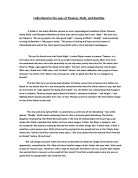The interactions between the patient and the nurses are portrayed as cold and impersonal. They do not view her as an individual. The patient’s body is compared to a “pebble”, an inanimate object with no identity. There is no evident communication between the nurses and the patient, they simply deliver the medications: “They bring me numbness in their bright needles, they bring me sleep”. In this hospital atmosphere the speaker’s detachment from the living world progresses: “Now I have lost myself I am sick of baggage”. She is watching her things disappear: “I watched my teaset my bureaus of linen, my books/ sink out of sight”, metaphorical for life slipping away from her. The impersonal contact with the medical staff contribute to the loneliness, the feeling of negation and emptiness and the patient’s separation from the human world. Plath’s depiction of the hospital setting may be a reflection of her own experiences. The patient’s vulnerability to the medical procedures and treatments are potentially based Plath’s treatments of electroshock therapy for psychiatric disorders. The side effects of these treatments are memory impairment and loss, confusion, and damages to the capacity of speech. This could explain for the patient’s loss of identity and inability to communicate with the outside world. The electroshock therapy has taken away her memory, leaving her uncertain of her own self: “They have swabbed me clear of my loving associations”. After electroshock treatment, memory slowly comes back to the patient the same way the narrator remembers her family when she looks at the picture of them and the tulips in her room spark memories.
The patient’s mentality highly correlates with his or her recovery. A patient who has no desire to fight for his or her life is less likely to survive than an optimistic patient. Although the narrator has no desire for life, her family and the tulips keep her from letting go. The guilt of abandoning her husband and child retain her from sinking: “Their smiles catch onto my skin, little smiling hooks”. The tulips are a gift to her, described as still in their “gift wrap”; they represent human sympathy and love.
The author uses color imagery to manifest the themes of life and death. The red of the tulips is symbolic for life, the color of blood and the heart and is associated with heat. The tulips, associated with spring, are introduced in the first line of the poem as a contrast to the winter outside and the whiteness of the hospital: “The tulips are too excitable, it is winter here”. The tulips seem to intrude on the white peacefulness the speaker experiences. She wants to escape herself and the problems in her life, “I only wanted/ to lie with my hands turned up and be utterly empty”, yet these flowers do not let her. The tulips anchor the patient to earth: “A dozen red lead sinkers round my neck”, which for her is more like drowning. They cause her to feel guilt and sadness and any emotion is stimulation to the mind and a sign of life. Prior to the tulips the speaker’s psyche was at rest, it was flat line without any meaningful thoughts or emotions. The flowers awaken the psyche and the reader is taken into the delusional spiral of thoughts that lie beneath the two-dimensional “effaced” patient. The self-resentment returns: “I see myself, flat, ridiculous”. As life returns to the patient the images of the poem grow more surreal: “through their [the tulip’s] white swaddlings, like an awful baby”. Plath’s use of the image of a “baby” is a manifestation of her own hospitalization due to a miscarriage. The patient is unable to distinguish the line between reality and illusion. She is persecuted by a sense of paranoia, believing that the tulips are watching her. The author’s personification of the tulips illustrates the patient’s psychological imbalance and hallucinations. The tulips come alive, she hears them breath and speak to her and feels as if they are suffocating her.
As the speaker recovers the second part of the poem the tone becomes more dynamic and the imagery more surreal: “the mouth of some great African cat”. The wall in her hospital room “seem to be warming themselves”, contrasting the cold winter introduced in the beginning of the poem. Her body is no longer a “pebble” but a “sunken rust-red engine”. The tulips come to life even more: “the tulips should be behind bars like dangerous animals”. The narrator’s desire to lock up the tulips is a representation of her protest against the restoration of health. Yet she becomes aware that life is inevitable: “I am aware of my heart: it opens and closes”.
The tone of the poem starts out as depressed and bleak then transforms into more dynamic and hopeful. The patient, although struggling, remains alive. The love from the people in the patient’s life, symbolized by the red tulips, prevents her from “sinking”. At the end of the poem she nowhere near well: “a country far away as health” but she is no longer a numb “shadow”. The “salt water” she tastes is her own tears; she is finally feeling something. The style, diction and literary technique Plath uses in the poem reflect her own horrors of mental illness and hospitalization. There is little structure to the poem; each stanza varies in meter. The lack of organization in each stanza is a reflection of the confusion and loss of control that the speaker feels. The only structure shared between the stanzas is the abundance of punctuation. Her extensive use of enjambment creates a slow rhythm throughout the poem, mirroring the patient’s life slowly dragging on: “Coming and going, breath by breath”.
References
K. Steinberg, K. Peter. “A celebration, this is: Biography”. December 2007.
www.Sylvia.Plath.info.html
Griffin, Marie, “Sylvia Plath-Poet, Author”
http://bipolar.about.com/cs/celebs/a/sylviaplath.htm





